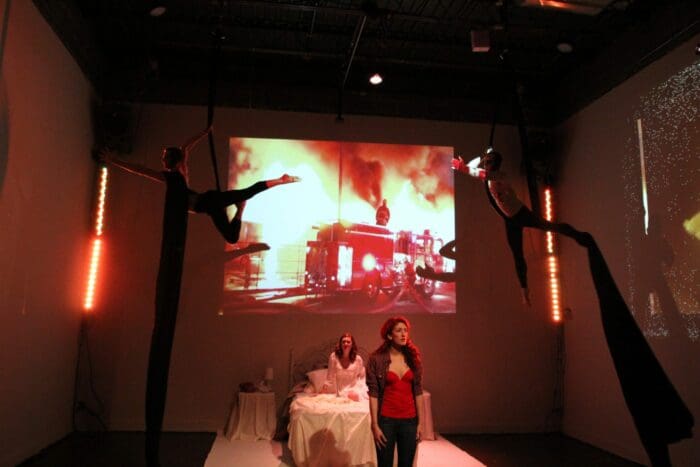 I feel like I have visited the sanctum of red-haired women and should dye my hair fuchsia plum before disclosing their secrets. Thankfully, having rocked (albeit fake) red hair at least twice in my life, I think that I am qualified to say this: One Old Crow Productions’ creative staging of Sherry Kramer’s David’s RedHaired Death is both engaging and thought-provoking.
I feel like I have visited the sanctum of red-haired women and should dye my hair fuchsia plum before disclosing their secrets. Thankfully, having rocked (albeit fake) red hair at least twice in my life, I think that I am qualified to say this: One Old Crow Productions’ creative staging of Sherry Kramer’s David’s RedHaired Death is both engaging and thought-provoking.
David’s RedHaired Death explores the impact of a young man’s death on his sister, Jean, and Jean’s association of his death with her burgeoning relationship with fellow red head, Marilyn. To that end, the play is both an examination of the ripple effects of death and the story of one woman’s struggle with her own sexuality. Kramer’s play embraces non-linear storytelling – a method of storytelling that I adore when it is utilized effectively. Non-linear storytelling can be challenging for an audience, but it is also a powerful tool for provoking curiosity and developing suspense. From the outset, Jean makes the audience aware that something terrible happened to David, but the details surrounding his death are stealthily integrated into the plot to delay the revelation of those details. Similarly, although the catalyst for Jean and Marilyn’s separation is not fully disclosed until the end of the play, there are hints very early on that their relationship does not survive David’s death.
Kramer’s plot has some flaws. At times, the relationship between Jean and Marilyn is uncomfortable because they share a few too may character traits. The two frequently come across as best friends sharing inside secrets, rather than as potential lovers sharing similar interests. Moreover, Jean and Marilyn often speak in their own red-haired secret language – okay, it is not so much a secret language as it is a bizarre ability to say the exact same thing at the same time and finish each other’s sentences in rapid-fire. These interactions are convoluted and confusing at times.
Fortunately, Diana Beshara and Elizabeth Simmons pull off the red-haired talk quite admirably. One and two person shows are difficult. It takes a lot of courage and raw talent to capture and keep an audience’s attention for the entire length of a play. I personally think that this feat is even greater when an actor is performing for a small audience. When the entire audience is 10 feet away from you, there is absolutely no place to hide. I get the impression that Beshara welcomed that challenge, and her presence on stage was never unwelcome. Beshara’s Jean is intriguing – she is insecure, coy, goofy, and remarkably self-aware (she also exhibits OCD tendencies when it comes to eating at McDonalds, although that may just be an addiction to McDonalds fries). Beshara also expertly handles Jean’s emotional mood swings, which are a product of the non-linear plot. Unfortunately, the character of Jean is so complex that Simmons’ Marilyn seems one-dimensional in comparison. Simmons is a solid actress and a decent stage partner for Beshara, but there were times when Marilyn came across as matronly when compared to Jean – an unfortunate observation given their supposed relationship.
As I have said in previous reviews, I detest the use of projections in live theatre. They tend to look cheesy and actors struggle to act around them (or with them depending on the purpose of the set piece). Let me re-phrase, I generally detest the use of projections, especially on Broadway where the audience should not be subjected to a cartoonish set if they are paying $150 to see a $13 million dollar production (despite enjoying the show, I am looking at you Big Fish). On occasion, a play incorporates projected images to great effect. In David’s RedHaired Death, Director Michael Rau and Projections Designer Asa Wember capably used projected images in plot-forwarding and visually interesting ways. For example, when Jean discusses her love for McDonalds, she introduces the audience to three different McDonalds designs on the walls surrounding the stage. As presented, the scene is pretty hilarious, but it would not be as funny without the visual depictions. That being said, not all of the projections were perfect. I found the camera stationed above Jean and Marilyn’s bed a bit too voyeuristic and unnecessary given the performance space – the camera work reminded me of a reality television show trying to capture canoodling between cast mates. Note to self: never use the term “canoodling” again.
The visual plot devices were not, however, limited to projections. Aerial work is an art form that is often found in off off-Broadway productions. Unfortunately, it frequently comes across as gimmicky and fails to lend any artistic integrity to the plot. While that was true at some points in Davids RedHaired Death, I welcomed the incorporation of the aerialists in the depiction of David’s death. Matthew Stuart and Sloan Bradford did a nice job of executing Tony Mitch’s beautifully choreographed depiction of David’s demise.
In the end, the magical world of the redheads, defying the constraints of time and space, was an enjoyable and compelling world to enter for an evening. Under Michael Rau’s direction, David’s RedHaired Death is one of the best innovative theatre productions that I have seen in New York and is worth a trip to Williamsburg.
David’s RedHaired Death runs through November 10 at Cantina Royal.

